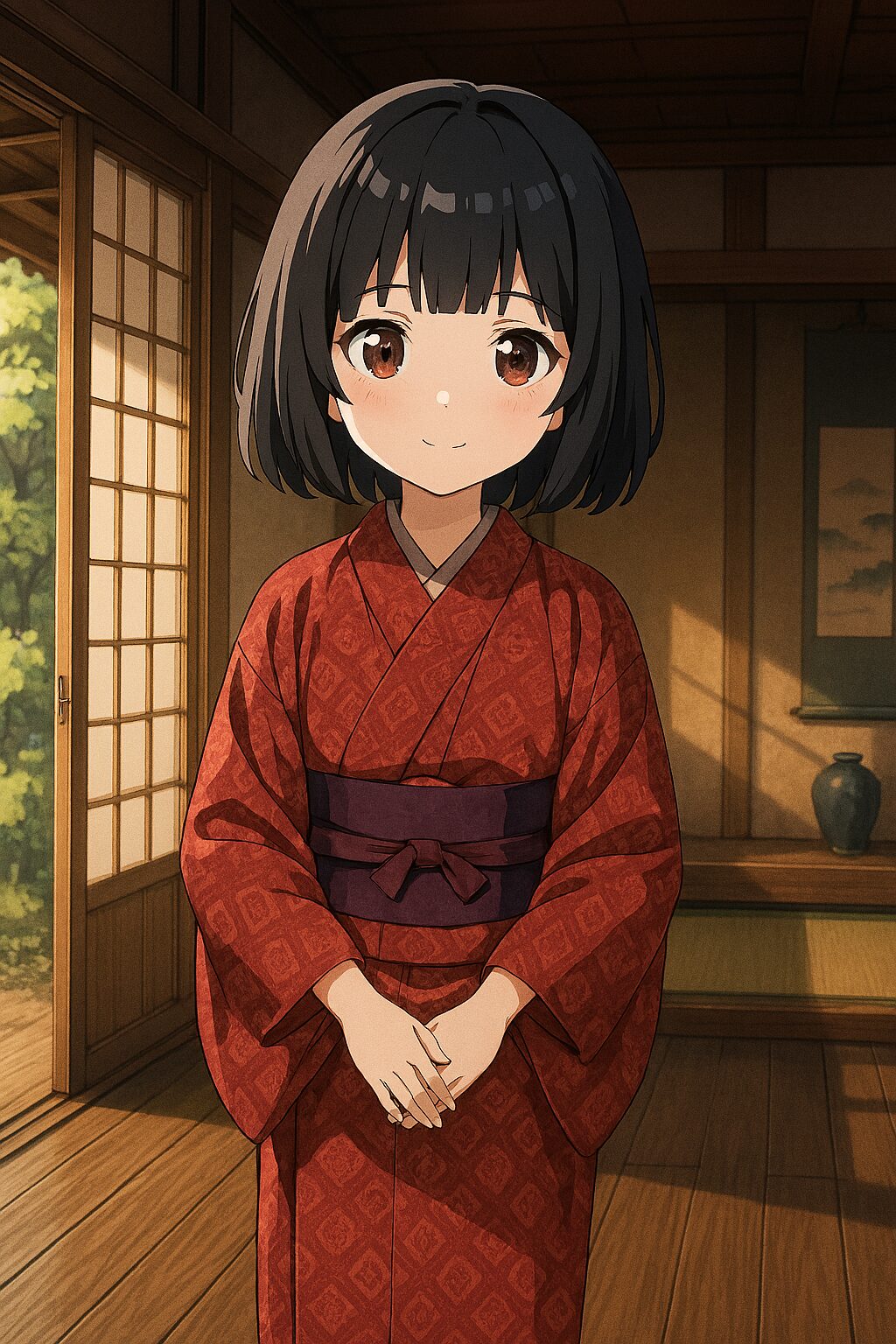- Introduction: A Presence You Can’t See, But Feel
- What Is Zashiki-warashi?
- Origins: Why a Child?
- Where to Find Zashiki-warashi: A Real-Life Location
- Zashiki-warashi in Pop Culture
- Stories of Fortune and Misfortune
- For International Readers: Japan’s Version of a House Spirit
- How to Invite Zashiki-warashi: Creating a Welcoming Home
- Conclusion: Living with the Invisible
- Related Links
- 座敷童とは何者か?―日本の「幸運を呼ぶ子ども」の伝説を世界へ
Introduction: A Presence You Can’t See, But Feel
In traditional Japanese homes, there are stories of invisible children who quietly roam the halls. They cause no harm, make no noise—yet somehow, their presence brings prosperity and happiness to the household.
This mysterious figure is known as Zashiki-warashi.
In this article, we’ll explore the folklore of Zashiki-warashi in a way that’s accessible to international readers. Whether you’re curious about Japanese spirits, drawn to mystical tales, or simply love cultural storytelling, this guide will help you understand one of Japan’s most beloved legends.
What Is Zashiki-warashi?
Zashiki-warashi is a type of spirit or yokai from Japan’s Tohoku region, especially Iwate Prefecture. It typically appears as a child aged 5 to 10, wearing a red kimono and sporting a bob haircut. Sometimes it’s visible to humans, sometimes not.
- Lives inside homes
- Appears as a child
- Brings good fortune
- Leaves when the household falls into misfortune
Many families believe Zashiki-warashi acts as a guardian spirit, watching over the home and its inhabitants.
Origins: Why a Child?
One theory suggests Zashiki-warashi is the spirit of a child who died young and remained in the home. In earlier centuries, infant mortality was high in Japan, and grieving families often felt their child’s soul lingered nearby.
Children in Japanese culture are seen as pure and sacred. Their innocence may explain why Zashiki-warashi takes the form of a child—it’s a symbol of untainted energy and spiritual protection.
Where to Find Zashiki-warashi: A Real-Life Location
The most famous place associated with Zashiki-warashi is Ryokufuso, a traditional inn in Ninohe City, Iwate Prefecture. Guests have reported hearing childlike footsteps, seeing doors open on their own, and feeling an unexplained presence.
Ryokufuso burned down in 2009 but was rebuilt over seven years. Today, it welcomes visitors from across Japan and abroad who hope to encounter the spirit firsthand.
Official Website of Ryokufuso (Zashiki-warashi Inn)
Zashiki-warashi in Pop Culture
- Appears in the anime Jigoku Shoujo (Hell Girl)
- Featured in the game Yo-kai Watch as a collectible spirit
- Inspired the 2014 short film Zashiki-warashi no Hanashi
Stories of Fortune and Misfortune
Many tales describe Zashiki-warashi bringing prosperity to a household. Businesses flourish, family members stay healthy, and harmony prevails. But when the spirit leaves—often due to neglect or discord—misfortune follows. Fires, illness, and financial ruin are said to occur after its departure.
In this way, Zashiki-warashi is not just a bringer of luck, but a mirror reflecting the emotional health of the home.
For International Readers: Japan’s Version of a House Spirit
Similar spirits exist in other cultures:
- Domovoi in Slavic folklore
- Brownie in Scottish tradition
- Tonttu in Finnish mythology
These spirits protect the home and reward kindness—just like Zashiki-warashi. Understanding it as a “Japanese house spirit” makes it easier to relate across cultures.
How to Invite Zashiki-warashi: Creating a Welcoming Home
Folklore suggests Zashiki-warashi prefers homes with:
- Strong family bonds
- Respect for children
- Clean and well-kept rooms
- Gratitude and humility
In essence, the spirit is drawn to kindness and harmony. Seeking Zashiki-warashi is also a way to reflect on how we treat each other at home.
Conclusion: Living with the Invisible
Zashiki-warashi is more than a ghost story. It’s a symbol of memory, emotion, and the unseen forces that shape our lives. Whether real or imagined, its presence invites us to cherish our homes, our families, and the quiet magic of everyday life.
For those exploring Japanese culture, the legend of Zashiki-warashi offers a beautiful starting point—one that blends mystery, warmth, and timeless wisdom.
Related Links
- Zashiki-warashi – Japanese Wikipedia
- Ryokufuso Official Site (Iwate Prefecture)
- Yo-kai Watch Official Site
- Household Deity – English Wikipedia
This article is part of a series introducing Japanese folklore to global audiences. May the spirit of Zashiki-warashi bring a little wonder to your day.
座敷童とは何者か?―日本の「幸運を呼ぶ子ども」の伝説を世界へ
はじめに:見えないけれど、確かにそこにいる存在
日本の古い家屋に、時折「見えない子ども」が現れるという話を聞いたことがありますか?その子どもは、誰にも危害を加えず、ただ静かに家の中を歩き回るだけ。けれど、その子がいる家には、なぜか幸運が訪れる――。
それが「座敷童(ざしきわらし)」と呼ばれる存在です。
この記事では、日本の民間伝承に登場する座敷童について、海外の読者にもわかりやすく、そして物語として楽しめるように紹介します。
座敷童とは?―定義と基本情報
座敷童は、日本の東北地方(特に岩手県)に伝わる精霊の一種です。見た目は5〜10歳くらいの子どもで、赤い着物を着ていることが多く、髪型はおかっぱ。人間の目には見えることもあれば、見えないこともあります。
主な特徴:
- 家の中に住みつく
- 子どもの姿をしている
- 幸運をもたらす
- 家を離れると不幸が訪れる
座敷童の起源―なぜ子どもの姿なのか?
座敷童の起源には諸説ありますが、最も有力なのは「早世した子どもの霊が家に留まった」という説です。かつて日本では乳幼児の死亡率が高く、家族が亡くなった子どもを思い続けることで、その魂が家に残ったと考えられていました。
また、子どもは「純粋で穢れがない存在」とされ、神聖視されることもあります。座敷童が子どもの姿をしているのは、そうした文化的背景があるのです。
座敷童が現れる家―実在する伝承地
座敷童の伝承が最も有名なのは、岩手県二戸市にある「座敷わらしの宿 緑風荘」です。この旅館には、座敷童が出るという噂があり、実際に多くの宿泊客が「子どもの足音を聞いた」「部屋に誰もいないのに障子が開いた」といった体験を語っています。
緑風荘は2009年に火災で一度焼失しましたが、7年半かけて再建され、現在も営業中です。座敷童に会えるかもしれない宿として、国内外の観光客に人気があります。
座敷童と現代文化―アニメ・ゲーム・映画にも登場
座敷童は、現代のポップカルチャーにもたびたび登場します。たとえば:
- アニメ『地獄少女』では、座敷童のような存在が登場
- ゲーム『妖怪ウォッチ』には「ざしきわらし」という妖怪が登場
- 映画『座敷童子のはなし』(2014年)は、座敷童をテーマにした短編作品
座敷童にまつわる逸話―幸運と不幸の境界線
座敷童に関する逸話は数多くあります。ある商家では、座敷童が現れてから急に商売が繁盛し、家族全員が健康になったという話があります。逆に、座敷童が家を離れると、その家に災いが起こるという話もあります。
このように、座敷童は「幸運の象徴」であると同時に、「家の状態を映す鏡」のような存在でもあるのです。
海外の読者へ―座敷童は「日本版ハウススピリット」
海外にも、家に住みつく精霊の伝承があります。たとえば:
- スラヴ神話の「ドモヴォイ」
- スコットランドの「ブラウニー」
- フィンランドの「トントゥ」
これらは、家を守る精霊として信じられており、座敷童と非常によく似ています。
座敷童に出会うには?―心構えと環境づくり
座敷童に出会うためには、いくつかの条件があると言われています:
- 家族の仲が良いこと
- 子どもを大切にすること
- 家を清潔に保つこと
- 欲張らず、感謝の気持ちを持つこと
これらは、座敷童が「居心地が良い」と感じる環境です。つまり、座敷童に出会うことは、家族の在り方や人間関係を見直すきっかけにもなるのです。
おわりに:見えない存在との共生
座敷童は、単なる妖怪ではありません。それは「家族の記憶」や「人の思い」が形になった存在であり、日本人の精神文化を映す鏡でもあります。
見えないけれど、確かにそこにいる――そんな存在と共に暮らすことは、私たちの心を豊かにし、日々の生活に小さな奇跡をもたらしてくれるかもしれません。



コメント